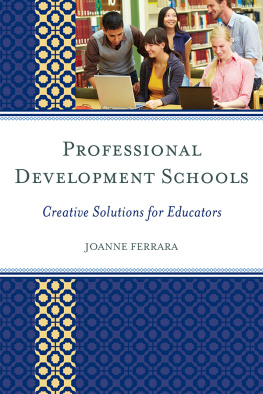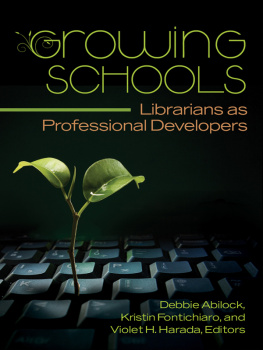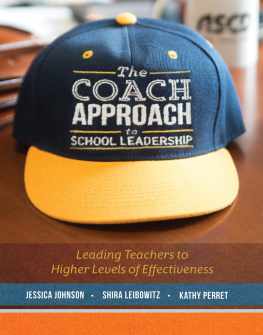Professional Development Schools
Creative Solutions for Educators
JoAnne Ferrara
ROWMAN & LITTLEFIELD
Lanham Boulder New York Toronto Plymouth, UK
Published by Rowman & Littlefield
4501 Forbes Boulevard, Suite 200, Lanham, Maryland 20706
www.rowman.com
10 Thornbury Road, Plymouth PL6 7PP, United Kingdom
Copyright 2014 by JoAnne Ferrara
All rights reserved . No part of this book may be reproduced in any form or by any electronic or mechanical means, including information storage and retrieval systems, without written permission from the publisher, except by a reviewer who may quote passages in a review.
British Library Cataloguing in Publication Information Available
Library of Congress Cataloging-in-Publication Data
Ferrara, JoAnne, 1955
Professional development schools : creative solutions for educators / JoAnne Ferrara.
pages cm
Includes index.
ISBN 978-1-4758-0286-3 (cloth : alk. paper) ISBN 978-1-4758-0287-0 (pbk. : alk. paper) ISBN 978-1-4758-0288-7 (electronic) 1. Laboratory schools. 2. College-school cooperation. I. Title.
LB2153.F47 2014
370.71'1dc23 2013046450
 The paper used in this publication meets the minimum requirements of American National Standard for Information SciencesPermanence of Paper for Printed Library Materials, ANSI/NISO Z39.48-1992.
The paper used in this publication meets the minimum requirements of American National Standard for Information SciencesPermanence of Paper for Printed Library Materials, ANSI/NISO Z39.48-1992.
Printed in the United States of America
To my colleague and friend Dr. Eileen Santiago, for sharing my vision for a professional development school partnership and for her unwavering support during the years that we worked together.
To my husband, Frank, and my daughters, Cesca and Tee.

Acknowledgments
My deepest gratitude to Dr. Kathryn Padovano, former dean of the School of Education at Manhattanville College, for her eagerness 13 years ago to help make my PDS dream a reality; to Dr. Shelley Wepner, current dean of the School of Education at Manhattanville College, for creating structures to bring the PDS model full scale.
For all the PDS stakeholders who shared their reflections throughout the bookin-service teachers, preservice teachers, principals, PDS directors, and NAPDS board members. To the three chapter contributorsDr. Helene Cunningham, Dr. Shelley Wepner, and Dr. Bruce Fieldwho eloquently describe their experiences in PDS work. To my PDS colleagues at the Thomas A. Edison Elementary School for opening their hearts and classrooms more than a decade ago to a vision for schooluniversity partnerships and for conceiving those PDS initiatives that are replicated throughout our PDS network.
A special thanks to Ann Spindel for her boundless energy, attention to detail, and agreeing to take one last look at the manuscript before it went to print. To my colleagues Drs. Marie Amoruso, Joyce French, and Monique Reilly for their feedback and insights. To my friends Maggie Fusco and Regina Gramola for ongoing support during the writing process. To Howard Pettus for keeping me capable, connected, and contributing. To my mentor Jerelyn Brofman for decades of help and sound advice.
My sincerest gratitude to the NAPDS for its leadership and promotion of a national forum for PDSs to flourish. Finally, thank you to those early PDS scholars Linda Darling-Hammond, Lee Teitel, and educators from the state of Maryland for sharing their research and resources.

Preface
This book is intended to share with others my deep commitment to the power of a special type of schooluniversity partnership in the form of a professional development school (PDS). The book helps school practitioners think creatively about finding solutions to challenges facing them as they compete with dwindling financial resources, reductions in staff, and implementation of state and federal education mandates. It provides practical tips for practitioners to bring additional support to their schools, their staff, and, most important, their students. The ideas presented are based on a decade of firsthand experience creating a PDS from the ground up.
The book begins with a conceptual framework to help readers understand the philosophy behind the PDS and its historical roots. Each chapter contains reflections as a means to introduce the topics presented along with specific steps and templates to guide the reader with useful suggestions for creating a PDS.
Organization
Chapter 1 provides a rationale for collaboration between preK12 schools and institutions of higher education to address the educational challenges confronting them. The chapter highlights the impact that the current economic crisis has on school funding, and it advises schools to seek creative ways to support teachers and students. Included in the discussion about educational challenges is understanding the importance of preparing new and practicing teachers for the increasing levels of student diversity in classrooms. The chapter concludes by asking readers to consider schooluniversity partnerships as a new model of schooling that unites preK16 educators in a concerted effort to take responsibility for the development and growth of all teachers.
Chapter 2 sets the context for the evolution of the PDS movement, including the tenor of education policy at the time of its inception. The chapter underscores the important role that PDS standards play in governance and the ways in which to assess a PDSs stage of growth and development. The chapter concludes with a rationale for creating a PDS partnership that benefits all stakeholders.
Chapter 3 discusses the process of creating a PDS, emphasizing the importance of starting small. The chapter calls for a specific set of guidelines to help partners understand PDS implementation along with the nuts and bolts associated with a successful partnership. Factors including organizational climate, building trust, and creating conditions for group ownership are among the important topics presented to assist readers during the early stages of PDS investigation and implementation.
Chapter 4 highlights a backward design approach to professional development within a PDS. When building the conceptual framework for implementing backward design, readers are instructed to consider the relationship among the desired results, data collection, and the alignment of programs that support job-embedded professional growth. In this chapter, backward design planning helps educators think with the end in mind so that the PDS program components are aligned with intended outcomes. The chapter encourages readers to embrace PDSs as entities for the sharing of resources and the bringing together of collective wisdom from higher education faculty and school-based educators.
Chapter 5 discusses a unique PDS partnership with a community school to illuminate approaches to whole child education. The community school philosophy sets out to strengthen families and communities as part of a comprehensive strategy to address povertys impact on learning by focusing on childrens social, emotional, physical, and intellectual growth. The PDS component of this alliance nurtures the professional growth of in-service teachers, the preparation of preservice teachers, and the success of students. As schools across the nation struggle to meet the increasing rates of children living in poverty and the accompanying educational challenges facing them, a PDS partnership with a community school facilitates creative ways to address student and teacher needs at the school site, under the umbrella of collaboration.
Next page









 The paper used in this publication meets the minimum requirements of American National Standard for Information SciencesPermanence of Paper for Printed Library Materials, ANSI/NISO Z39.48-1992.
The paper used in this publication meets the minimum requirements of American National Standard for Information SciencesPermanence of Paper for Printed Library Materials, ANSI/NISO Z39.48-1992.